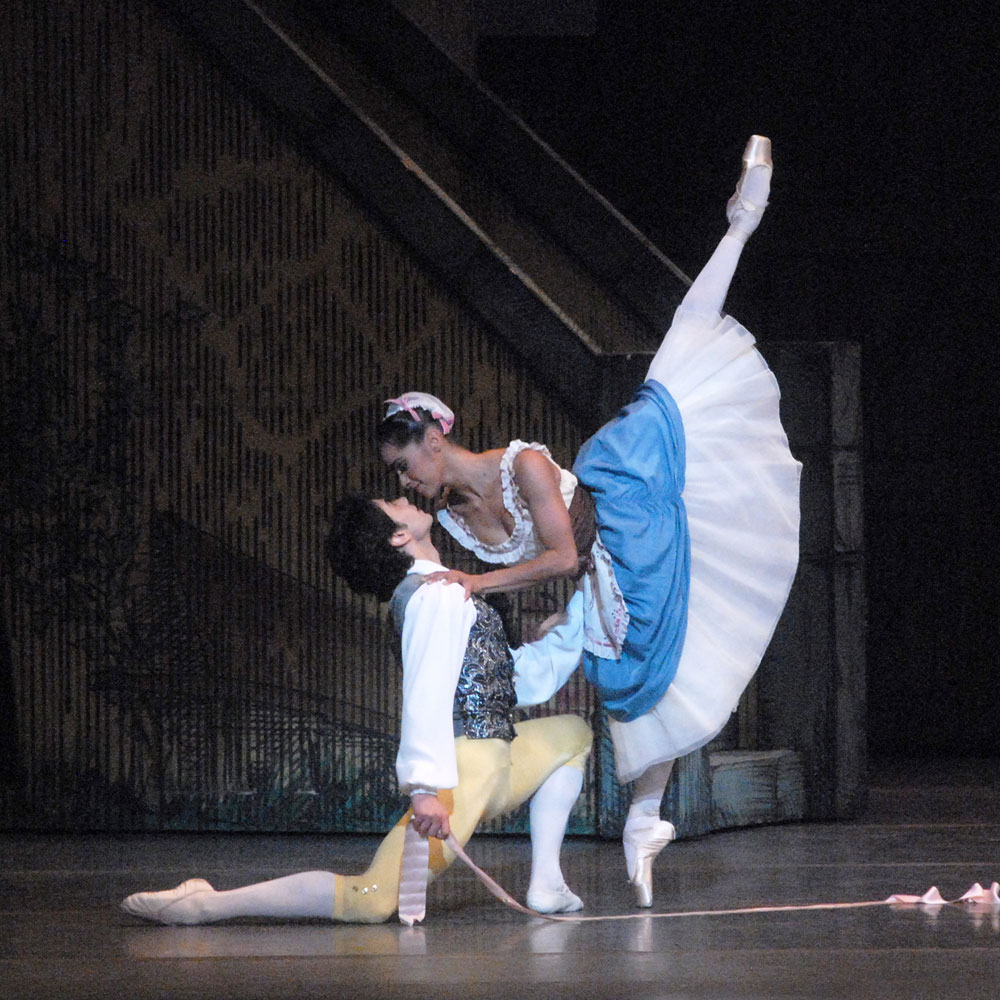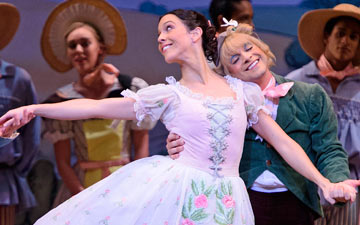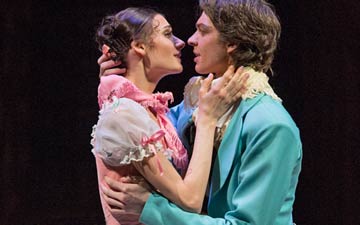
© Rosalie O’Connor. (Click image for larger version)
American Ballet Theatre
La Fille Mal Gardée
★★★★★
New York, Metropolitan Opera House
25, 26, 27 May 2016
www.abt.org
Ribbons and Bows
Some works of art get under your skin from the very first moment you come across them. Frederick Ashton’s 1960 ballet La Fille Mal Gardée is one of them. In fact, you may find yourself falling under its spell during the opening bars of its sweet, gently-hued overture. (The arrangement, by John Lanchbery, is a liberal re-arrangement of Ferdinand Hérold’s 1829 score, with a few later additions.) The front curtain, by Osbert Lancaster, depicts a neat, sun-kissed country scene out of a children’s book: rolling hills, cows grazing, a little bridge over a stream. Meanwhile, we hear the happy call and response of birds, warbling and chirping on the flute and woodwinds. (The flute plays a dominant role in the score.) The first dancing we see is exectued by a trio of chickens, lorded over by a high-stepping rooster. This is the country as we imagine it, as it should be. “A leafy pastoral,” Ashton wrote of the setting in a 1960 essay.
La Fille Mal Gardée is being revived this spring by American Ballet Theatre after an absence of ten years, in the midst of an uncharacteristically rich season. There are far fewer of the usual warhorses: no Manon, no La Bayadère. Instead we get two new ballets, two mixed bills, a Ratmansky retrospective, and two works by Ashton (plus a few other things). What a breath of fresh air! Everyone should run to see La Fille, which continues through the weekend. Your life will be the better for it.
The story is simple: a prosperous farmer, the Widow Simone, tries to marry off her pretty but disobedient daughter Lise to the dotty son of a wealthy landowner (Alain). But Lise has her heart set on Colas, a handsome and cheerful lad without much in the way of prospects. The two kids do everything they can to subvert Widow Simone’s plan, sneaking kisses at every possible opportunity. Their young love, both innocent and sensual, is a force that will not be denied, like the birds and the bees.
Their attraction expresses itself in games that start out childishly and turn serious midway. In the first of these, they play with a ribbon – ribbons are a constant theme – fluttering it, wrapping themselves in it, playing horsy. (The ribbon becomes the reins, the bit.) As they loop it ever more tightly around them, they end up closer and closer; you can feel the temperature rising. In the second act, they repeat this ritual with two handkerchiefs. A simple gesture, placing a handkerchief around a lover’s neck, opens the floodgates of emotion, offering a foretaste of bliss. The two arch their backs, overcome, and share their first real, adult kiss.
The ribbon has a formal function as well. It ignites Ashton’s choreographic imagination, suggesting endless variations. In the harvest scene in act 1, Lise turns slowly in attitude, supported by a wheel of ribbons extending from her hand to those of her friends. In a scene at a spinning wheel, a wool thread (a different kind of ribbon) connects Lise to her mother. Before long, though, it begins to choke the dowager. There is an intricate Maypole dance, one of several group numbers that enliven Ashton’s rustic world, giving everyone in the large cast a moment to shine. Ashton’s interweaving dances show American Ballet Theatre at its freest and most unified. For as long as the ballet is going on, the real world disappears.
Lise’s scenes with her mother are another source of pleasure. The two are constantly going at it; Lise is lazy and ill-behaved and Simone tries to keep her in line. But Simone, who is played by a man (Roman Zhurbin and Marcelo Gomes on alternating nights), has a sunny streak as well. She’s fussy, big-bummed, and loves to dance. In fact, an invitation to dance is the surest way to improve her mood. There is a famous clog number during the harvesting scene. She taps, slides, rocks back and forth, falls, jumps. Both Gomes and Zhurbin revel in the characters’ little idiosyncrasies, her bossy walk, her temper tantrums, her nattering. Zhurbin accentuates the sweetness at the character’s heart; once she forgives Colas, she lifts him off the ground in a hearty embrace. Gomes takes a more slapstick approach. Both do a mean clog dance. What a happy surprise it is to see Gomes, the ultimate prince and partner, take on this comic role.
The clogs, which are also worn by four of Lise’s friends, inspire another idea: they can be used as pointe shoes. Ashton loves a good prop. The boys dance with sticks; the harvesters dance with sickles. A young man plays the flute. Colas dances with two bottles.
The choreography for Colas is meant to prove what a happy, carefree lad he is. He jumps over bottles, high-steps with flexed feet, spins on bent legs, plops into the air and hovers there for an extra beat. Of the three dancers I caught in the role, Herman Cornejo was the most eager to win over the girl (Misty Copeland) through the ardor of his dancing. Each spin and leap was for her. A series of tricky turns that end with the leg out in arabesque were impeccable, as was his manège of leaps and sauts de basque. But he had trouble with a big lift in the harvest pas de deux in which Colas presses Lise into the air so that she appears to perch there casually with her legs crossed. It didn’t quite come off. On May 26, James Whiteside danced with Stella Abrera; his strong partnering served him well. Both this and an earlier spinning overhead lift looked effortless. His Colas was a scamp, brash and showy, with more emphasis on the dancing and less on laying on the charm. Jeffrey Cirio was the most boyish of the three; his dancing was clean, crisp, joyous.
Lise is one of ballet’s most irresistible characters: funny, high-spirited, silly and headstrong. You root for her from the first, even though you can easily understand her mother’s exasperation. She balks at her chores and is easily bored; left alone, she slides down staircases, daydreams, peers through windows longingly. One of her most winning scenes is a little monologue in which she imagines her future life with Colas: the ring, the wedding dress, her big pregnant belly, three kids. Colas catches her in the act of dreaming. Three kids? No, ten!, he cries out.

© MIRA. (Click image for larger version)
Ther are four Lises this season, all but one (Gillian Murphy) of them débuts. On May 25, Misty Copeland looked somewhat nervous in the first act, but relaxed in the second. She was sweetly vulnerable in the mime scene. The following night, Stella Abrera took a goofier approach; she compensates for her refined, sophisticated look – Copeland is smaller – by playing Lise as a bit of a ditz, with big eyes given to dismayed looks. She’s less of a teenager, more of a gangly girl. Boylston was relaxed, melting, good hearted, and wholly uninhibited. She seemed the most herself in the role.
Each dancer blossomed at a different moment in the choreography. Copeland looked earth-bound in the jumpy, zig-zagging solo accompanied by a waltz from Donizetti’s Elixir of Love, but glowed in the slower, more expansive final pas de deux, which ends with a gesture toward the audience, her mother, and Colas. Abrera’s footwork was clean and crisp throughout; her backward-traveling bourrées were especially lovely. She is a slightly reticent dancer, which brings out the character’s gentler, shyer qualities. (Her Lise reminded me a little bit of the first- act Giselle.) What impressed most about Boylston was her sense of ease; he pliant backbends, the soaring but easygoing jumps. And her phrasing; she made the choreography sing.
A note on the secondary characters. One of the loveliest moments in the ballet is the flute dance during the harvest scene. A boy gets up to play a jaunty tune while executing a flurry of entrechats. Patrick Frenette made an especially stylish impression here, beating his feet neatly as his upper body swayed with the melody. Alexei Agoudine was hilarious as the notary’s assistant, a kind of Bartleby the Scrivener, aloof from the mayhem around him.
And then there’s Alain, the dimwitted son of Simone’s prosperous neighbor, a character both comic and touching. Ashton has given him a staccato step that is halfway between a creep and a hop, which he executes with flapping hands and eager face, a flower bobbing atop his head. He’s a fool, but so good-natured you can’t help but love him. He’s happiest when dancing with the girls, who tease and tickle him. The moment in which he comes face to face with the young lovers kissing behind a locked door is a small tragedy. But he gets over it quickly; there are no victims in Ashton’s world. Craig Salstein plays him as an excitable spaz, with a vaudevillian flair. Arron Scott is more understated, more limp and doll-like, more poignant.
Ashton’s ballet, so intricately made, leaves room for such shadings. Each character, no matter how small, is a perfect little miniature. If you let your eye wander, it will be rewarded: you might see Widow Simone swatting a fly or the neighbor squeezing her backside as he pushes her onto the buggy. In the last few years ABT has become a company of compelling actors as well as dancers. Each has a part to play in Ashton’s happy little world. La Fille Mal Gardée is a ballet that glows from within, lighthearted, tender, and bursting with happy ideas.

















You must be logged in to post a comment.